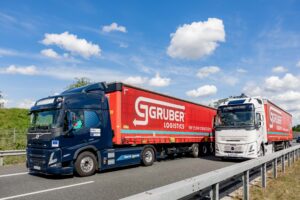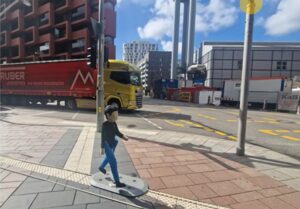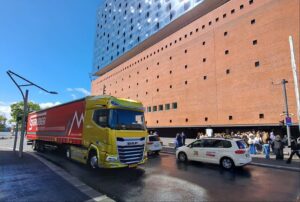General description of the German Use Case and related technological tests
The transport industry faces significant challenges: traffic congestion and inefficient traffic flow delay deliveries, accidents involving vulnerable road users (VRUs) pose significant safety risks, and the shortage of truck drivers further exacerbates supply chain issues. Hamburg use case is actively testing innovative technologies to tackle these challenges and enhance efficiency and safety.
Our Use Case focuses on gradually laying the foundation for SAE Level 4 (L4) autonomous driving. To achieve this goal—enabling trucks to drive on the motorway or through the city to the harbour—Hamburg UC is testing and evaluating innovative solutions contributing to L4 autonomy.
One key approach is leveraging physical and digital infrastructure (PDI) to support L4 driving in complex environments. ITS-G5 improves traffic control and supports autonomous decision-making through real-time updates and preliminary test results by facilitating seamless communication between vehicles and infrastructure. PDI integration for automated vehicles expands the boundaries of vehicle autonomy, enhancing safety, streamlining logistics, and continuously optimizing performance through data-driven insights. The MODI impact evaluation helps identify areas for improvement, assess the effectiveness of services, and boost overall transportation efficiency.
To optimize traffic flow, we are implementing GLOSA (Green Light Optimal Speed Advisory) & Time-to-Green, allowing trucks to anticipate traffic light phases and adjust their speed accordingly. This reduces stop-and-go traffic, lowers fuel consumption, and improves traffic efficiency.
Ensuring VRU safety is another critical aspect. We conduct dummy tests that simulate real-life hazardous situations, training driver assistance systems to better protect pedestrians and cyclists.
Another key focus for Hamburg UC is enhancing vehicle capabilities to enable safe motorway-to-harbour driving. A crucial element of this is the Merging Case, where vehicles communicate with each other and construction sites to facilitate safer and more efficient lane merging and highway entry. This Vehicle-to-Everything (V2X) communication reduces the risk of accidents and improves overall traffic coordination.
Through these tests, we are refining and validating the technologies required for L4 autonomy, bringing us closer to real-world implementation. Improved traffic forecasting, enhanced safety measures, and optimized driver assistance systems pave the way for autonomous trucks.
In the long run, these innovations will enable more efficient logistics with fewer accidents, reduced driver shortages, and a more sustainable transport industry. By continuously testing, validating, and optimizing these technologies, we are laying the foundation for a future where autonomous trucks become a reality on European roads.
The Hamburg use case brings together key partners, including Gruber Logistics, DAF Trucks, Volvo, New Mobility Solutions, BAST (Germany’s Federal Highway Research Institute), and the City of Hamburg. These stakeholders are working together to integrate intelligent infrastructure with autonomous truck technology to make logistics operations safer and more efficient.
Description of CW19 Tests
As part of the European MODI project, the City of Hamburg is testing automated and connected driving functions for trucks in real-world conditions. The goal is to explore innovative mobility solutions that enhance safety, efficiency, and sustainability in urban and highway environments. Three concrete Use Cases are being implemented:
Cooperative Merging
This scenario explores cooperative merging between two automated trucks, either from an on-ramp or ahead of a construction zone. Volvo developed the function, and simulations are being validated through public tests in Hamburg. It will increase traffic safety, smoother merging behavior, and a technical foundation for future automated freight corridors.
Technical description about CW19 Tests
Merging onto a highway is known to be highly risky and very stressful for drivers. Leveraging the latest V2X communication standard for maneuver coordination, Volvo has developed an advanced engineering function, “Cooperative Merging”. This function uses V2X communication to enable vehicles to mutually negotiate their trajectories, allowing them to merge safely and automatically without human intervention.
Recently, with the support of Hamburg city and German transport authorities, Volvo successfully tested and demonstrated the ‘Cooperative Merging’ function within public highway traffic in Hamburg. The results show that V2X communication extends the operational design domain of Level 2 automated driving functions, relieving drivers from stressful merging scenarios while maintaining high traffic safety.
Through the EU project MODI, Volvo has explored the potential of V2X communication to enhance driver awareness and extend the field of view for automated driving functions by incorporating non-line-of-sight sensing capabilities. These advancements are expected to improve traffic safety, increase transport efficiency, and reduce energy consumption and emissions, thereby contributing to smart mobility and a greener society. Wen Xu, Specialist Engineer for Vehicle Connectivity at Volvo Group

Description of CW21 Tests
Technical description about CW19 Tests
VRU Testing
In the heart of Hamburg, at a key urban intersection, tests are underway on an advanced detection system for pedestrians and cyclists designed to significantly enhance road safety. Installed by the City of Hamburg, the system can detect and track the trajectories of pedestrians and cyclists up to 300 meters away. It uses sensors and predictive algorithms to create a dynamic virtual environment that identifies potential hazards in real time.
This Use Case focuses on how automated trucks interact safely with Vulnerable Road Users (VRUs), such as cyclists and pedestrians, particularly during right-turn maneuvers. A city intersection was equipped with advanced VRU detection technology. The data collection will be used to see how infrastructure can support automated driving in urban environments.
The collected data is digitally transmitted to approaching vehicles—particularly automated trucks—through vehicle-to-infrastructure (V2I) communication technologies. This allows heavy-duty vehicles to anticipate critical behavior from vulnerable road users and take preventive action to avoid collisions. During the tests, mannequins simulating children crossing the street unexpectedly are used to assess the system’s effectiveness in realistic scenarios.

Time to Green
This Use Case integrates urban C-ITS data (e.g., SPaT messages) into the truck’s HMI, enabling features like Time-to-Green or Green Wave Speed Assist. The City of Hamburg provides the necessary data, supporting OEMs in preparing for real-world trials. It will reduce fuel consumption, emissions, support, and enhanced vehicle-to-infrastructure connectivity.
Integrating this system with autonomous truck operations offers multiple benefits:
- Increased safety, through early detection and prevention of collisions with pedestrians and cyclists;
- Improved traffic efficiency via more innovative intersection management;
- Reduced emissions, thanks to smoother, optimized driving;
- Enhanced support for urban logistics, particularly in light of growing freight transport demand.
Through this pilot, Hamburg reinforces its position as a European leader in urban mobility innovation, promoting digital and sustainable solutions to meet safety and efficiency challenges in urban transportation and logistics.



